![Shibuya Scramble Crossing (渋谷スクランブル交差点, Shibuya sukuranburu kōsaten), commonly known as Shibuya Crossing, is a popular pedestrian scramble crossing in Shibuya, Tokyo, Japan.[1] It is located in front of the Shibuya Station Hachikō exit and stops vehicles in all directions to allow pedestrians to inundate the entire intersection. The statue of Hachikō, between the station and the intersection is a common meeting place, which is almost always crowded.Three large video screens mounted on nearby buildings overlook the crossing, as well as many static advertising signs. The Starbucks store overlooking the crossing is one of the busiest in the world. Given its heavy traffic and amount of advertising, it is compared to Times Square in New York City and Piccadilly Circus in London.](https://www.asianstudies.org/wp-content/uploads/Feld1-300x193.jpg)
As the country is undergoing significant demographic changes toward a smaller older population, there is now widespread recognition that the government must be very serious about its commitment to ensuring no child is left behind. This article underscores that rich nations face serious inequality issues; in particular, it provides an overview of how child poverty is measured, what survey data sets indicating poverty are available, and what kinds of public policies on poverty alleviation are already in place. In this article, I make the case that education policy, taking into account the equality of educational and life opportunities for all children, is crucial to Japan’s future well-being.
Dynamics of Japan’s Demographic Changes and Social Inequity Conditions
In the current postgrowth era, overall population decline and aging, the changing population structure, and the widening of inequalities are some of the most striking characteristics of Japan. As of January 1, 2017, its population was estimated at close to 126 million, continuing the drop that began in 2008 when the population peaked at a little over 128 million. Elderly people sixty-five years of age or older now account for a record-high 27.17 percent of the total population. The 2017 OECD Economic Survey of Japan highlights imminent sociodemographic trends. The population is projected to decline by almost 25 percent between 2010 and 2050. At the same time, the share of elderly people will rise from 26 percent in 2015 to 40 percent in 2050.1
From an economic viewpoint, issues with labor and skill shortages are expected to be major constraints to growth in the years to come. The ratio of working-age persons (aged fifteen–sixty-four years) to persons aged sixty-five and over will fall from 2.3 to 1.3. This is the so-called “gerontic” or “elderly dependency ratio” commonly used to measure the close connection between demographic and economic developments. It is driven by low birth rates below replacement, which leads to fewer children and then to fewer working-age persons, and by increasing life expectancies leading to more people living into old and very old ages (Figure 1). As a consequence, the percentage of households with children already decreased from 46.2 percent in 1985 to 23.4 percent in 2016, whereas the percentage of households with elderly increased from 26.0 percent to 48.4 percent.2
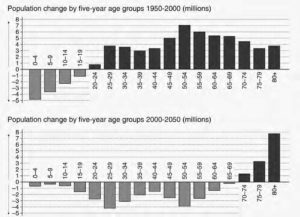
While internal migration to metropolitan regions is continuing and there are too few immigrants, hundreds of small cities and towns are at risk of disappearing altogether very soon because the path of shrinking places is self-reinforcing.3 It is a downward spiral with potentially destructive effects on the economic, social, and cultural life; and once started, there is no proven way to stop it or even reverse it. Such cities and towns are referred to as “marginal settlements” or “zero sustainability villages” in official government publications, places where the people feel left behind in life. The consequence is that socioeconomic inequity conditions at local and regional scales are expected to further worsen in Japan. As the state has a responsibility to practice a policy of social justice, it has to address these equity issues. This is even more important, as the OECD indicated that the gap between rich and poor, measured by indicators such as the distribution of household disposable income and poverty, had widened in Japan since the mid-1980s.4 The challenge for urban and regional policymakers is to develop strategies that stabilize shrinking communities in the years to come—or to terminate such policies, concentrate scarcer resources on growing metropolitan regions, and ultimately admit the dismantling of settlements. This debate touches upon very fundamental normative aspects of state activity in both social and regional policy.
Conceptions of Poverty
“Poverty” is a universal concept used in all countries in the world. But it is used in many different ways and can imply a wide range of conditions
and experiences. Also, there can often be a disconnect between the use of “poverty” by policymakers, academics, and other experts, and the way it is understood by some communities and those individuals with the direct experience of poverty. For instance, we know that some people are unwilling to identify themselves as living in poverty because of its associations with extreme deprivation in the developing world or with destitution, homelessness, and discrimination. In general, the lack of resources over time to maintain a certain standard of living is seen as being a central element of poverty.
According to the United Nations Educational, Scientific, and Cultural Organization (UNESCO), “absolute poverty” measures poverty in relation to the amount of money necessary to meet very basic needs such as food, clothing, and shelter. It is not concerned with broader quality of life or inequality issues in a given society. In order to recognize that individuals also have important social and cultural needs, the concept of “relative poverty” defines poverty in relation to the economic status and standards of living of other members of a given society.5 “Income” and “consumption expenditure” are frequently used as quantitatively measurable and comparable indicators. But it must be recognized that poverty is a multidimensional phenomenon. Other aspects that may be important include:
• Lack of opportunities for sustained and rewarding employment
• Difficulty in accessing education and leisure opportunities
• Ill health and disability, both a greater likelihood of experiencing them and the additional costs that this can
place on the household
• Poor access to services and lack of participation in public life
• Social exclusion, discrimination, insecurity, and anxiety
• Unequal distribution of resources within households, that is between men and women, generations living
together, and adults and children
In other words, what “relative poverty” measures in rather rich countries like Japan is not real material hardship but the inequality between the rich and the not-as-rich: we look at levels of income and standards of living that are significantly lower in “poor” families when compared to the national average, but much higher when compared to developing countries.
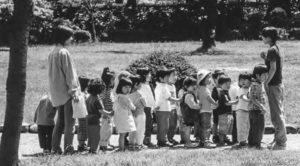
According to the 2017 OECD Economic Survey of Japan, the average household net adjusted disposable income per capita is US $27,323 a year, not much less than the OECD average of US $29,016. But there is a considerable gap between the richest and poorest Japanese: the top 20 percent of the population earn more than six times as much as the bottom 20 percent.6 Thus, relative poverty is a measure of unequal income distribution, with rising poverty rates indicating that Japan has become a more unequal country. As the OECD’s Better Life Index emphasizes, “While money may not buy happiness, it is an important means to achieving higher living standards and thus greater well-being.”7 In Japan, in particular, it is a common practice that pupils attend costly juku (private after-school tutoring classes), which poor households just cannot afford. How to facilitate the removal of such barriers is a key to ensure educational equity for all children and to create effective programs for poverty reduction.
This is a major social and regional policy task because child poverty has both a socioeconomic and a spatial dimension: first, it affects the health and happiness of children and their families, and also their potential to access higher education and well-paid jobs, and actively contributes to a society faced with the challenge of a rapidly aging and declining population; second, the spatial patterns of child poverty at local and regional scales should matter to policymakers because society’s most vulnerable groups tend to be concentrated in disadvantaged areas, worsening politically undesirable inequity conditions. A resulting poverty of aspiration with regard to recognizing and developing individual potential is particularly problematic in Japanese society, which is rigorously education-oriented and almost obsessed with educational attainment.

Survey Data on Child Poverty
The public and political interest in child poverty issues in Japan has grown stronger since 2013, when the United Nations Children’s Fund (UNICEF) report “Child Well-being in Rich Countries” compared Japan with thirty-one other countries.8 It revealed a remarkable mixed performance of Japan, achieving top ranking in the “education” and “behaviors and risks” dimensions. But it was rated only tenth for “housing and environment,” sixteenth for “health and safety,” and twenty-first for “material well-being.” As the five dimensions are closely correlated, the result was interpreted as a warning that Japan might also lose ground in the “Education” and “Behaviors and risks” rankings in the future.
Japan also ranked behind many other rich countries in the 2016 UNICEF report “Fairness for Children.”9 The report addressed inequalities in child well-being in forty-one countries of the European Union (EU) and the OECD according to how children at the bottom are allowed to fall behind the “average” child in terms of income, education, health, and life satisfaction. Japan was rated thirty-fourth out of forty-one countries on “inequality in income” and twenty-seventh out of thirty-seven on “inequality in education.” The United Nations repeatedly stressed that countries that perform badly on inequalities in child well-being are in breach of the UN Convention on the Rights of the Child.
In Japan, the Ministry of Health, Labor, and Welfare (MHLW) has conducted the Comprehensive Survey of Living Conditions each year since 1985, and the
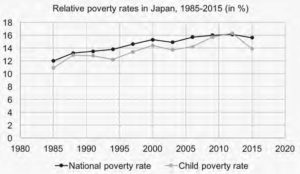
survey contains data on poverty every three years (Figure 2).10 The definition of “relative poverty” here is simply an annual income per person of less than 50 percent of the national median household income (after taking taxes and benefits into account). For 2012, the poverty line was JPY 1.22 million (USD $10,847)11, and the nationwide poverty rate was 16.1 percent accordingly. The poverty rate for children aged zero to seventeen was 16.3 percent, with more than half of all children living in single-adult households being affected. That means one in every six Japanese children lived in relative poverty, marking a record high since the first survey in 1985. The regional variation among prefectures, which are the unit of administration below the central government, continued to decrease in terms of both total population and child poverty rates. In over half of poor families, the daily food budget per family member was less than JPY 300 (USD
$2.67), and children in over 80 percent of them suffered from malnutrition. Other problems related to child poverty, such
as bullying at school, abuse, and neglect, require the attention of Japanese society as a whole.
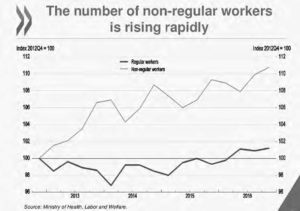
As a response to the report, the Japanese Diet passed a new Law on Measures to Counter Child Poverty (Kodomo no hinkon taisaku no suishin ni kan suru hōritsu) in June 2013, which came into force in January 2014. However, a decisive factor behind increasing child poverty has been the growing number of people with nonregular jobs (Figure 3). In November 2015, the government published data showing that the proportion of nonregular workers in Japan had reached 40 percent of the nation’s employed workforce; it was only 15 percent in 1984. The average wage for irregular workers was only about 60 percent of that of regular employees.12
Considering the outcomes of the MHLW 2016 Comprehensive Survey of Living Conditions released in April 2017, the situation has slightly improved since then. It found that in 2015, 15.6 percent of all Japanese lived below the poverty line of JPY 1.22 million (USD $10,847), down 0.5 percent from 2012, and the poverty rate for children aged zero to seventeen was down to 13.9 percent. However, it should be noted that the proportion of single-adult households with children being impoverished has remained constantly high since 1985. Still, more than half of the father-child or mother-child families live in relative poverty. Methodologically, data is not fully comparable to the previous survey due to the fact that Kumamoto Prefecture in southwestern Japan was exempted because it was hit by a severe earthquake during the survey period. Moreover, the report does not really explain why the country has seen these changes in poverty or specify what kinds of policies or strategies helped reverse the trend to avoid cycles of poverty over generations. To avoid speculation, further inquiry into this needs to be conducted by the full range of stakeholders. What we know for sure is that measures that help close educational achievement gaps are a key element of Japan’s strategy.
Policy Approaches to Address Child Poverty
Japan’s Law on Measures to Counter Child Poverty calls for action to ensure equal opportunities in education for all children, irrespective of their socioeconomic environment. Specific approaches undertaken by the government to address child poverty include the expansion of financial and learning support for families. Financial support for people living in poverty is traditionally centered on a social welfare system called seikatsu hogo (livelihood protection). The central government provides 75 percent of the funds and local governments finance the remaining 25 percent. Measures to support the cost of children’s education and increase the maximum amount of child support allowances to single parents have been included in this system. Another focus has been on the provision of additional child care capacity, which at the same time is part of the government’s initiative to enhance women’s participation in the labor market and enable more flexible working arrangements.
In addition, the central government urged prefectures and municipalities to evaluate the effectiveness of existing policy measures and develop individual strategic plans for the implementation of learning support systems. For example, in Okinawa Prefecture, a survey found that existing systems to provide educational support for poor families are not working properly. The prefectural government thus introduced a six-year plan to ensure that all families know about a program subsidizing the costs of school learning materials and that all municipalities operate learning support classes. These classes are provided on the basis of specific education programs for children in low-income families.
The government’s so-called Chiiki Mirai Juku (Regional Future Tutoring School), launched by the Ministry of Education in 2015, is a community-based learning support program for children in secondary education. Using classrooms in local chūgakkō (junior high schools), the support is offered free of charge to pupils in need. The community collaboration brings together families, schools, and qualified tutors such as university students and retired teachers. They are recruited by local private initiatives or nonprofit organizations operating the programs on behalf of the municipal governments. Located in the northern suburbs of the Greater Tokyo area, Saitama City-based Saitama Youth Support Net (www.saitamayouthnet.org) is just one example of Japan’s vital civil society sector. In sum, 2,000 junior high school districts were covered by the program in 2015, and the figure is targeted to rise to 5,000 in 2019. In 2016, kōtōgakkō (senior high schools) were also included in the program, and the utilization of digital technologies to accelerate learning achievements was strengthened.
Overall, improvements in local learning environments are expected to support children living in poverty who are more likely to fall behind at school. At the same time, new opportunities for citizens’ engagement and encounters are provided that may enable participating communities to enhance local quality of life, and hopefully effectively respond to declines in left-behind communities.13
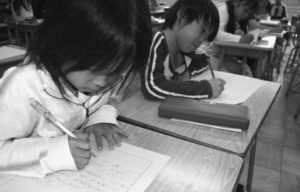
Conclusion
Household income is the most commonly used indicator of relative poverty, and higher household income improves children’s access to quality education. Conversely, income and wealth inequality directly impact educational achievement. This suggests the need for public policies that reduce educational achievement gaps in the first place. As there is a great deal of talent and strength among people living with poverty, the role of the public sector in providing effective backing for self-help and support groups such as community networks and NPOs in focusing on education are central to help people cope with and overcome poverty. Government agencies in particular should continue to look at themselves as community catalysts in many ways, and also with regard to the creation of job opportunities in collaboration with employer and business initiatives. Japanese society can simply not afford to leave behind children with learning difficulties, who are more
likely to have a poor family background.
Certainly, there is a primarily economic connotation implied, and activities to address educational inequalities thus have instrumental value. However, as the European Network of Ombudspersons for Children (ENOC) noted, providing equal access to education and the empowerment of all learners also has intrinsic value: “Education should strengthen the capacity of children to enjoy the full range of human rights, and empower children through the development of skills, learning and other capacities, human dignity, self-esteem, and self-confidence.”14 As a matter of everyday experiences though, combating poverty and inequality is not a fast-selling item, and it will remain a major challenge for many years to come even in a wealthy country like Japan. Promoting occupational stability and improving the livelihoods of “nonregular workers” without permanent full-time jobs, redefining traditional gender roles, and promoting female equality in the
workplace must form part of an integrated approach. ■
ADDITIONAL TEACHING RESOURCES
Brumann, Christoph, and Evelyn Schulz, eds. Urban Spaces in Japan: Cultural and Social Perspectives. London: Routledge, 2012.
Chiavacci, David, and Carola Hommerich, eds. Social Inequality in Post-Growth Japan: Transformation During Economic and Demographic
Stagnation. London: Routledge, 2016.
Matanle, Peter, Anthony S. Rausch, and The Shrinking Regions Research Group. Japan’s Shrinking Regions in the 21st Century: Contemporary
Responses to Depopulation and Socioeconomic Decline. Amherst: Cambria, 2011.
NOTES
1. “OECD Economic Surveys: Japan 2017,” Organization for Economic Co-operation and Development, last modified April 13, 2017, https://
tinyurl.com/y6u5vwhm.
2. “The 2016 Comprehensive Survey of Living Conditions” (Heisei 28-nen kokumin seikatsu kiso chōsa no jōkyō), Ministry of Health, Labor, and
Welfare, accessed July 15, 2017, https://tinyurl.com/ybdd9l2a.
3. See Cristina Martinez-Fernandez et al., “Shrinking Cities in Australia, Japan, Europe, and the USA: From a Global Process to Local Policy
Responses,” Progress in Planning 105 (2016): 1–48; and Peter Matanle, Anthony S. Rausch, and The Shrinking Regions Research Group,
Japan’s Shrinking Regions in the 21st Century: Contemporary Responses to Depopulation and Socioeconomic Decline (Amherst: Cambria, 2011).
4. “In It Together: Why Less Inequality Benefits All,” Organization for Economic Co-operation and Development, last modified May 21, 2015,
https://tinyurl.com/y6wscqgn.
5. “Poverty,” United Nations Educational, Scientific, and Cultural Organization, accessed July 15, 2017, https://tinyurl.com/p8yw8jn.
6. Household adjusted disposable income includes income from economic activity, property income, and social benefits.
7. “OECD Better Life Index,” Organization for Economic Co-operation and Development, accessed July 15, 2017, http://www.oecdbetterlifeindex.
org/topics/income/.
8. UNICEF Office of Research-Innocenti, “Child Well-Being in Rich Countries: Comparing Japan,” United Nations Children’s Fund, accessed
July 15, 2017, https://tinyurl.com/ycwowqxh.
9. UNICEF Office of Research-Innocenti, “Fairness for Children: A League Table of Inequality in Child Well-Being in Rich Countries,” United
Nations Children’s Fund, accessed July 15, 2017, https://tinyurl.com/ya5hxol2.
10. The Ministry of Health, Labor, and Welfare publishes the Comprehensive Survey of Living Conditions reports at https://tinyurl.com/y8a-
4bz7l.
11. JPY/USD exchange rates are as of October 4, 2017, available at www.reuters.com.
12. See Hiroaki Miyamoto, “Reforming Japan’s Dual Labor Market,” East Asia Forum, last modified December 23, 2016, https://tinyurl.com/
ycw4lmpr.
13. See Gerrit J. Hospers, “Policy Responses to Urban Shrinkage: From Growth Thinking to Civic Engagement,” European Planning Studies 22,
no. 7 (2013): 1507–1523.
14. “Position Statement on Equal Opportunities for All Children in Education, Adopted at the 20th ENOC General Assembly, September 22,
2016, Vilnius,” European Network of Ombudspersons for Children, accessed July 15, 2017, https://tinyurl.com/y7pn64we.

